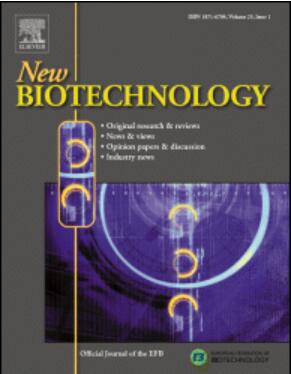Valorization of waste cooking oil for bioproduction of industrially-relevant metabolites in Ashbya gossypii
IF 4.9
2区 生物学
Q1 BIOCHEMICAL RESEARCH METHODS
引用次数: 0
Abstract
Waste cooking oil (WCO) is a byproduct of culinary processes, which undergoes degradation due to high temperatures during frying and cooking. Beyond its detrimental effects on health, including potential carcinogenic effects, WCO poses a significant environmental threat, emphasizing the need for urgent recycling efforts. Valorization of WCO as a carbon source for microbial fermentations emerges as a feasible alternative in a bioeconomy context. The aim of the present work is to explore the ability of Ashbya gossypii, a natural overproducer of riboflavin that is currently used in the industrial production of the vitamin, to exploit WCO for the production of industrially relevant metabolites such as riboflavin, folates, biolipids and monoterpenes. Our results demonstrate that WCO is an effective carbon source for A. gossypii bioproduction of riboflavin, folates and biolipids, reaching among the highest titers described so far in flask fermentation: riboflavin titer (312.5 mg/L) increased 4.8-fold compared to glucose-based medium; folate production reached 7.6 mg/L; and the intracellular lipids were above 80 % of the cell dry weight. In contrast, the production of the monoterpenes limonene and sabinene was not improved with the utilization of WCO. Taken together, our results present a proof-of-principle for the implementation of a novel bioprocess for the valorization of WCO using the industrial fungus A. gossypii.
废食用油在棉叶Ashbya gossypii中用于工业相关代谢物生物生产的价值评价
废食用油(WCO)是烹饪过程的副产品,在油炸和烹饪过程中由于高温而降解。除了对健康的有害影响,包括潜在的致癌影响外,世界海关组织还构成重大的环境威胁,强调需要紧急进行回收工作。在生物经济背景下,将WCO作为微生物发酵的碳源进行增值是一种可行的替代方案。目前工作的目的是探索Ashbya gossypii的能力,Ashbya gossypii是一种天然的核黄素过量生产者,目前用于维生素的工业生产,利用WCO生产工业相关的代谢物,如核黄素、叶酸、生物脂和单萜烯。我们的研究结果表明,WCO是棉蚜生物生产核黄素、叶酸和生物脂的有效碳源,在烧瓶发酵中达到了迄今为止所描述的最高滴度:核黄素滴度(312.5 mg/L)比葡萄糖培养基提高了4.8倍;叶酸产量达到7.6 mg/L;细胞内脂质高于细胞干重的80% %。而利用WCO后,单萜烯类化合物柠檬烯和sabinene的产量并没有提高。综上所述,我们的研究结果为利用工业真菌棉丝芽孢杆菌实现WCO增值的新生物工艺提供了原理证明。
本文章由计算机程序翻译,如有差异,请以英文原文为准。
求助全文
约1分钟内获得全文
求助全文
来源期刊

New biotechnology
生物-生化研究方法
CiteScore
11.40
自引率
1.90%
发文量
77
审稿时长
1 months
期刊介绍:
New Biotechnology is the official journal of the European Federation of Biotechnology (EFB) and is published bimonthly. It covers both the science of biotechnology and its surrounding political, business and financial milieu. The journal publishes peer-reviewed basic research papers, authoritative reviews, feature articles and opinions in all areas of biotechnology. It reflects the full diversity of current biotechnology science, particularly those advances in research and practice that open opportunities for exploitation of knowledge, commercially or otherwise, together with news, discussion and comment on broader issues of general interest and concern. The outlook is fully international.
The scope of the journal includes the research, industrial and commercial aspects of biotechnology, in areas such as: Healthcare and Pharmaceuticals; Food and Agriculture; Biofuels; Genetic Engineering and Molecular Biology; Genomics and Synthetic Biology; Nanotechnology; Environment and Biodiversity; Biocatalysis; Bioremediation; Process engineering.
 求助内容:
求助内容: 应助结果提醒方式:
应助结果提醒方式:


